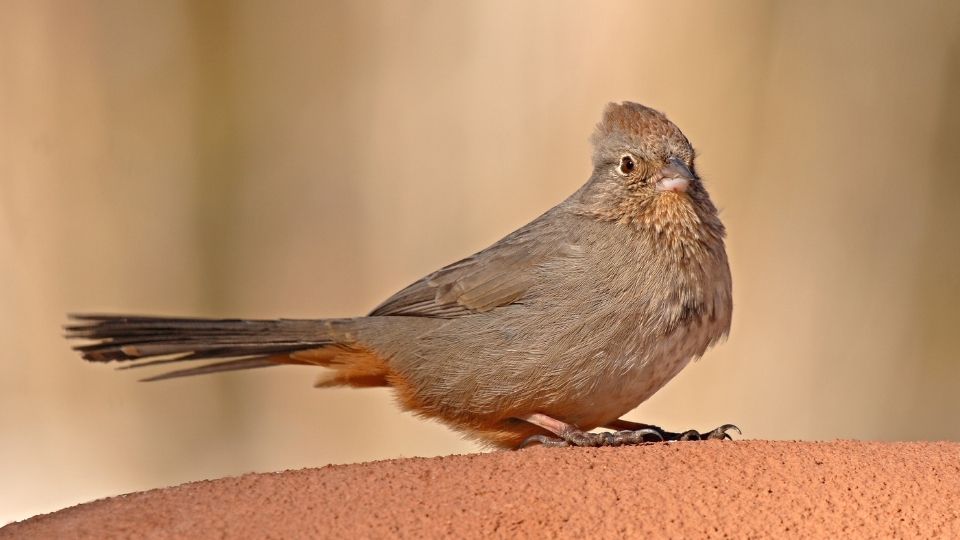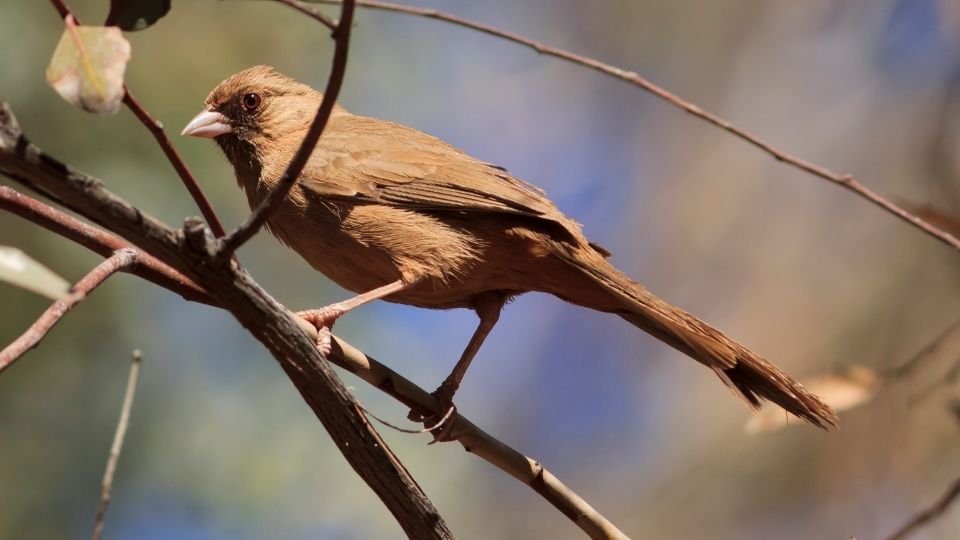Towhees are Passeriformes from the family Passerellidae. Identifying the spotted towhee, California towhee, rufous sided towhee, canyon towhee, and Eastern towhee is all a matter of knowing what range each bird resides in. You will find 6 out of 8 towhee birds that reside in the United States.
While in total there are 8 species, only 6 types of towhees are found in the United States. All towhees are part of the Passerellidae family; the family that encompasses all new world sparrows and juncos bird species. Most species of towhees were once considered so similar they were grouped under the same scientific name until about the 1990s.
After the 1990s, these beloved North American birds were been studied and separated into two genera. The genus Pipilo is the three migrant species of towhees, and the genus Melozone towhees are non-migratory. Using range maps, physical features, and a few other unique attributes, you can accurately identify all six types of towhees in the United States!
Spotted Towhees and Their Similarity to Eastern Towhees
The eastern towhee and spotted towhee used to be combined under the classification rufous-sided towhee. It wasn’t until 1995 that the two similar species were separated due to distinct genetic characteristics. Song difference was listed as one of the reasons for the split, though there were several factors.
Eastern towhees and spotted towhees have a lot in common with each other, as both have red eyes and white marks on their black wings. Eastern and spotted towhees have red chests as well. When the spotted towhee was divided into separate species, the eastern towhee kept the scientific name, Pipilo erythrophthalmus. The spotted towhee became Pipilo maculatus. The two species sometimes interbreed in places where their range map overlaps.
While the overall color pattern of the two towhees is very close, they are also strikingly similar to the American robin! Telling these similar species of towhees apart is tricky, but there are a few key identifiers to tell the difference between the towhee and American robins.
Robins have:
- Black eyes
- A small black head
- Gray wings with black feathering
- Orange beaks
- Full red breast
- A white spot under the tail
The eastern and spotted towhee both have:
- Red eyes
- A thicker black head with a black bib and back
- Black beaks
- White spots or markings on their wings
- White belly between the rufous-brown sides

Spotted Towhee Identification
The definitive white spots on the spotted towhee are one of the biggest physical differences. Three rows of white spots cover their wings. Males and females look similar, with a rufous-brown chest divided by a white streak in the middle. But the male spotted towhee’s rufous chest is much deeper and brighter in color than the females.
Spotted towhees (Pipilo maculatus) are migrant birds found in western ranges from Mexico to Canada. During the winter, their range map overlaps with eastern towhees in Texas, Oklahoma, and Kansas. Breeding spotted towhees may share a part of their territory with eastern towhees in South Dakota and southeast Saskatchewan, Canada.
Male spotted towhees are crooners, spending between 70-90% of their day singing their fast trill song at the beginning of the mating season. Like other towhees, spotted towhees are monogamous and mate for life. Once the male towhee has found a mate, his prolific singing will lessen.

California Towhee Identification
The California towhee has a grayish-brown body, with the overall color being more gray than brown. California towhees have a large chest with feathers that are still gray but about a shade lighter than the gray upper parts, and rust-brown around the eyes.
The California towhee (Melozone crisis) is found exclusively in Southern Oregon scrublands and along the California and Baja California coasts. Attracting them to your backyard is relatively easy if you live in their territory. They love millet and milo, which they will eat from the ground rather than from a bird feeder.

Canyon Towhee Identification
The canyon towhee is found in Arizona, Colorado, Texas, the western panhandle of Oklahoma, New Mexico, and mainland Mexico. They are non-migratory birds, spending the entire year in their home range. This is great news for birders trying to tell the canyon towhee apart from the look-a-like California towhee. Since neither of these similar species migrates, their range never overlaps.
Canyon towhees (Melozone fusca) are brownish-gray, with the color appearing more brown than gray. Rust feathers shade the face and under the tail. The canyon towhee has a sleeker body, with no noticeable difference in color between the upper parts and chest. The rust brown shaded on the canyon towhee’s face does not reach their reddish-brown eyes.
The canyon towhee is another ground forager that favors seeds. While they will use a platform or tray-style bird feeder, they are just as happy to eat seeds from the ground. They love millet, milo, and black-oil sunflower seeds.

Abert’s Towhee Identification
The Abert’s towhee (Melozone aberti) is much like its relatives, the California and canyon towhee. Even though Abert’s towhee shares the overall brownish gray color and the brown rust patch under its tail, one really obvious physical trait sets it apart. A black patch is around Abert’s towhee’s beak from eyes to chin.
The Abert’s towhee range map falls between the California and canyon towhee ranges. There is some overlap with the canyon towhee in Arizona and New Mexico. This makes the black patch around the beak especially helpful for telling the two apart.
Abert’s towhees sing less often than other towhees, making them harder to locate in the brushy vegetation that lines the rivers of streams in the Sonoran Desert. Abert’s towhees attract water, so a well-planted yard with plenty of water sources will attract this shy little bird to backyard bird feeders.
Green-Tailed Towhee Identification
Green-tailed towhees (Pipilo chlorurus) have a few unique physical features similar species don’t have, the most obvious being the rufous crown atop their heads. Green-tailed towhees are gray, with yellow-green feathers on their wings and tails, and they also have a white spot under the chin. Both males and females have striking rufous brown crowns, but the female crown is smaller and duller.
Green-tailed towhees are found in Mexico and the western United States. This migratory bird spends winters in the south, ranging as far east as Texas. Like all towhees, these delightful little birds are ground foragers and prefer brushy scrub areas.
Eastern Towhee
Eastern towhees have black upper-parts, white splotches on the wings and tail, and a wide white chest patch splits rufous brown sides. The female eastern towhee looks just like the male eastern towhee, but her upper parts are tawny brown.
Eastern towhees (Pipilo erythrophthalmus) are also known for their unique song. Along with the slow trill, the eastern towhee song includes a distinctive “chewink” sound. During mating season, this bold little songbird can be found performing for prospective mates from high perches.
As the name suggests, Eastern towhees are found in the eastern half of the United States. They range as far north as the shared New York-Canada border during breeding season. Breeding Eastern towhees can also be found in and around Winnipeg, Canada.
Eastern towhees love to forage in leaf litter. This is where they find the millipedes, snails, and caterpillars that make up the bulk of their diet. Eastern towhees have even been known to eat the occasional small lizard or salamander!
Fun facts about the towhee birds of North America:
- They are all ground foragers even though they don’t eat the same foods.
- Only three species of towhees are migrant birds- eastern, green-tailed, and spotted towhees. They share the Genus Pipilo.
- Abert’s, canyon, and California towhees are not migratory birds. They are part of the same Genus, Melozone.
- Sightings of towhee birds often happen in brushy forest edges, tangles of thickets, shrubby areas, and anywhere with abundant low trees.
- Subspecies of the eastern towhee in Florida and Georgia may have yellow or white eyes instead of the typical red eyes.
- Towhees nest in low shrubs, laying 2-6 eggs per brood, with up to 3 broods a year.
- Towhees are one of the most often victimized by cowbird brood parasite behavior. Cowbirds lay their eggs in the towhee nest, leaving the towhee to hatch and raise cowbird young.
The similar species of towhees have a lot in common, but there’s plenty of difference to help tell them apart. Whether you’re a seasoned birder or just getting started, this handy guide will help you identify all 8 types of this energetic bird. Wherever you are in the US, you’re sure to find at least one species of the lovely and somewhat elusive towhee near you!

